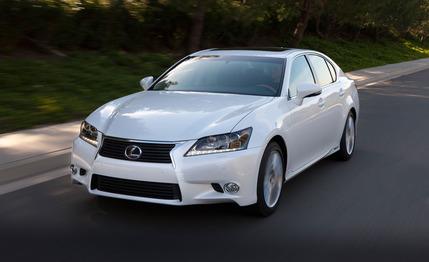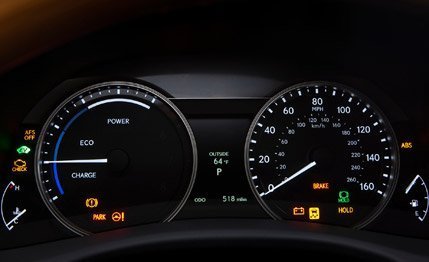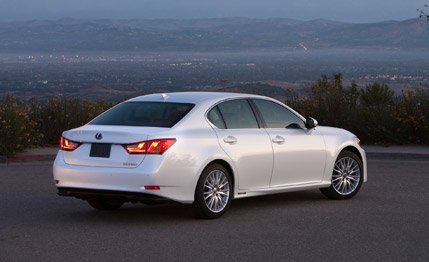
 Instrumented Test
Instrumented Test


The third piece of the 2013 Lexus GS puzzle is the hybrid model, the GS450h. Since it trumps the regular and F Sport versions of the GS350 as the most powerful member of the sporty new GS family, we expected a performance sedan. But it’s a hybrid, right? Aren’t hybrid cars about fuel economy and feeling superior? Definitely. But a hybrid’s electric motors can also be thought of as an extra source of power. They can provide performance and economy; it all depends on how you drive.
Well, in this case, the GS450h may be the most powerful member of the GS lineup, but it is also the least sporty of the bunch. The GS450h wafts itself over the road with the same sort of tranquillity as its big brother, the LS460. There’s a complete absence of road or engine noise, the ride is plush, and the seats are as soft as buttery mashed potatoes. This sort of luxury is Lexus’s trademark, and it’s a delight, provided you aren’t expecting a sports sedan. We didn’t love the mouselike control for the Lexus infotainment system, but the rest of the interior is a soothing cocoon. Dress up the hybrid with the optional bamboo interior trim, and the cabin brightens significantly. Grasp the bamboo steering-wheel rim, and your hand will guess Jaguar, Bentley, something British?


Start the GS450h, and you’ll notice there is no tachometer, just a power and charging gauge next to the speedo. Turn the Drive Mode knob to sport, and the power gauge disappears and transforms into a tach, numbers and all. In addition to gaining a tachometer, switching to sport sends more juice to the electric drive motor to boost its role in acceleration—our acceleration tests were done in sport mode. The system uses two electric motors, one under the hood that primarily handles charging and the other in the rear differential to help drive the wheels; the latter works in concert with the Atkinson-cycle V-6 to produce 338 hp (32 more than the rest of the GS lineup). Alone, the direct- and port-injected V-6 makes 286 hp, 20 less than the 3.5-liter V-6 in the GS350.
Drive it like a Prius, and the GS450h handily beats the fuel economy of the gas-only GS models. In our hands, it achieved 27 mpg in a mix of highway and city driving. More careful drivers should be able to match the EPA’s fuel-economy ratings of 29 mpg city and 34 highway.
Despite the additional power of the hybrid system, in our testing it’s still the slowest member of the new GS lineup, turning in a 0-to-60-mph time of 5.7 seconds. The GS350 F Sport and the GS350 AWD we’ve tested were slightly quicker to 60, at 5.5 and 5.6 seconds. Passing power in the hybrid is better than in the gas-only versions, however, as the electric motor provides a turbolike boost once the GS450h is up to speed.


Aside from a slight letdown as the hybridized powertrain revs past 5000 rpm, the GS450h pulls with a satisfying surge. Unlike CVTs coupled to small engines that moan and drone under full-throttle acceleration, the V-6 never protests as the transmission keeps it boiling near the redline. We moved the shifter into the manual gate to see if the CVT offered any preselected “gears” but found that manual mode seems to merely hold the engine at elevated rpm rather than provide distinctly defined ratios. A sports sedan should have a direct—or a nearly direct—connection between the engine and transmission; the GS450h’s transmission lags as it figures out the interplay of internal-combustion and electric motors. The slipping feel characteristic of the CVT is not very sporty, nor is it very satisfying when you’re trying to hustle. This transmission is much better suited to cruising or stretching a gallon of gas.
Base pricing for the 2013 GS450h remains unchanged from last year’s, starting at $59,825. Major options include several Luxury packages that add niceties such as better leather, 18-way-adjustable front seats, adaptive headlights, and 18-inch wheels (17s are standard). A Mark Levinson audio upgrade runs $1380, navigation adds $1735, and a precollision system with adaptive cruise control runs $2000. A trio of other driver-assistance options can be added, each for $500: lane-keeping assist, a blind-spot monitor, and an active parking system.
Lexus might claim to have made its GS into a sports sedan that will satisfy enthusiasts, but the hybrid version seems to have a different mission. Powerful? Yes. Efficient and serene? You bet. Sporty? Not so much.